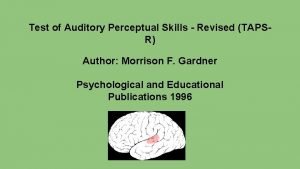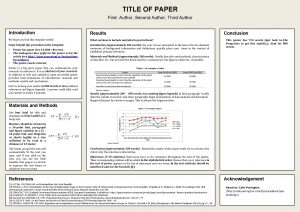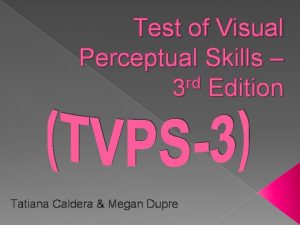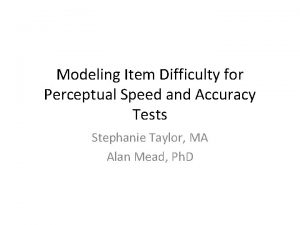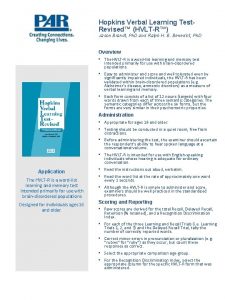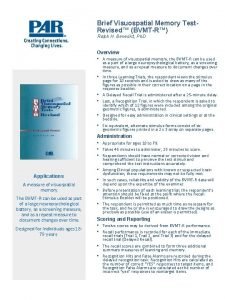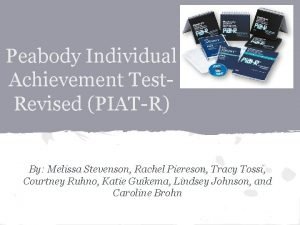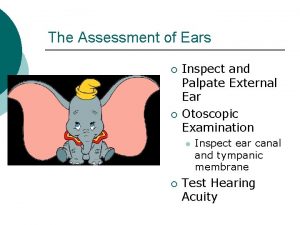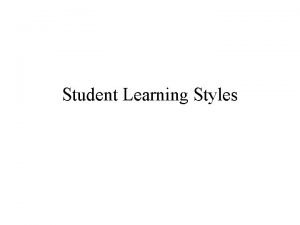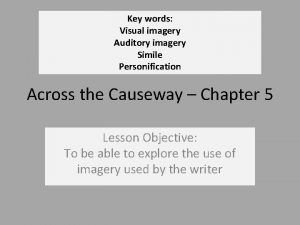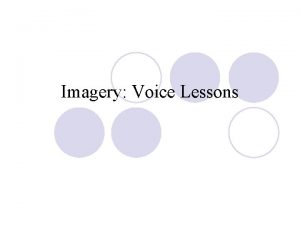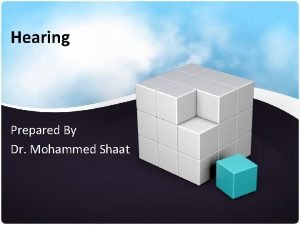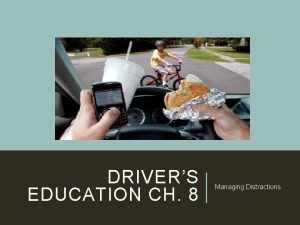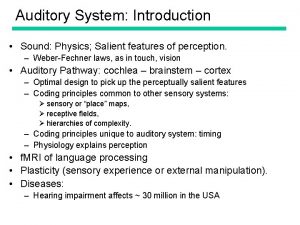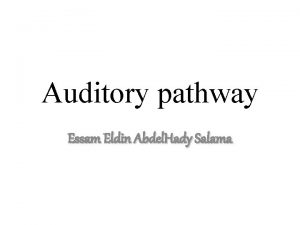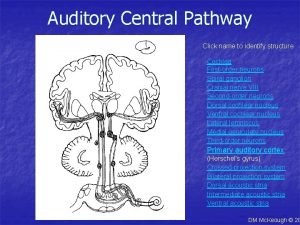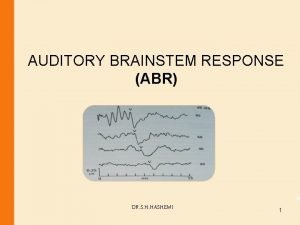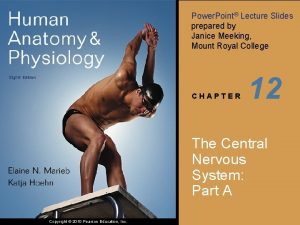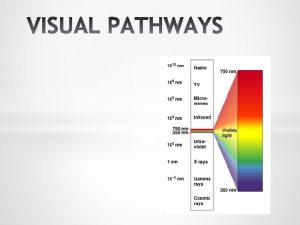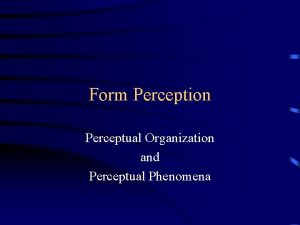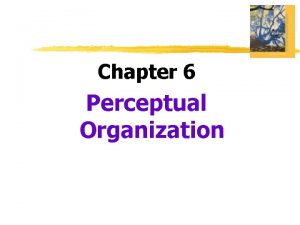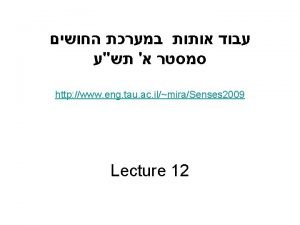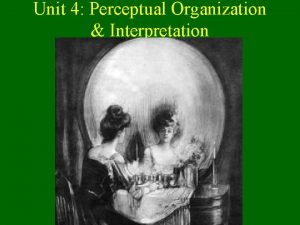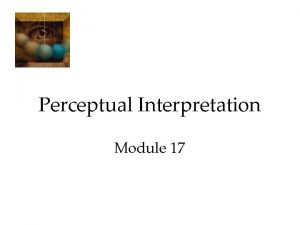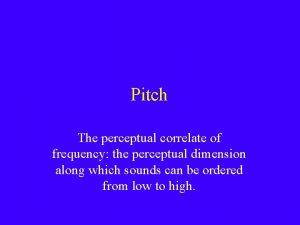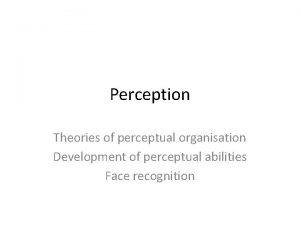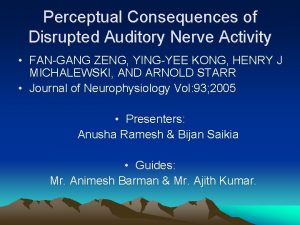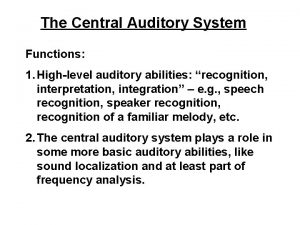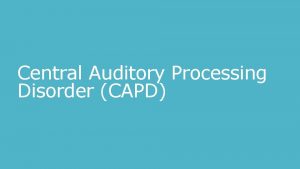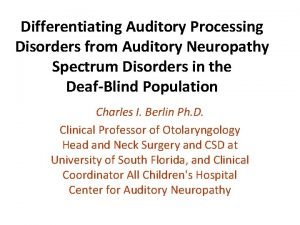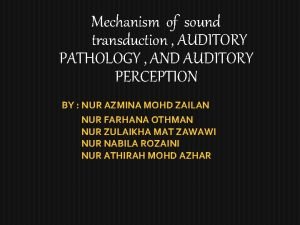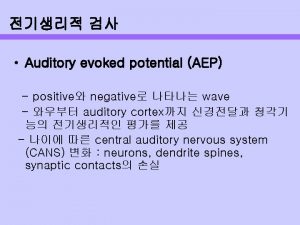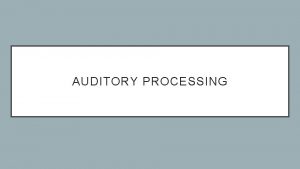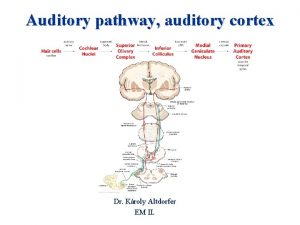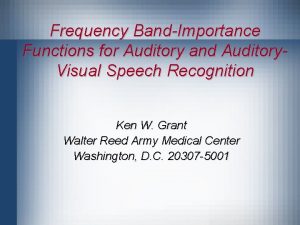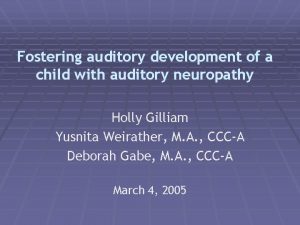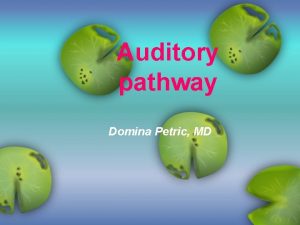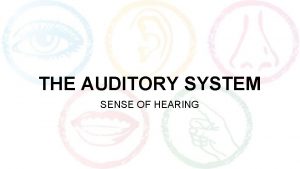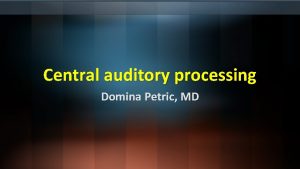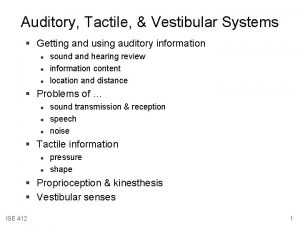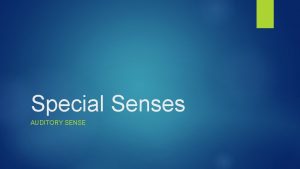Test of Auditory Perceptual Skills Revised TAPSR Author

























- Slides: 25

Test of Auditory Perceptual Skills - Revised (TAPSR) Author: Morrison F. Gardner Psychological and Educational Publications 1996

What is Auditory Processing Disorder? Short Video

Purpose and description TAPS-R TEST OF AUDITORY-PERCEPTUAL SKILLS-REVISED Designed to quickly diagnose students who may have difficulties with auditory -perceptual processing skills that are necessary for learning

Area of Knowledge and Skills Assessed ● Number Memory (Forward) ● Number Memory (Backwards) ● Sentence Memory ● Word Memory ● Interpretation of Directions ● Word Discrimination ● Auditory Processing (Thinking and Reasoning) What We Do With What We Hear?

Administration Oral Instrument and Materials Manual Test Booklet Parent Questionnaire Tests of auditory processing may be administered by an audiologist, speech-language pathologist, psychologist, or other clinician trained to understand the role of auditory processing in the development of learning disorders (Martin & Brownell, 2005).

TAPS-3 The test of Auditory Processing Skills, Third Edition (TAPS-3) by Nancy A. Martin and Rick Brown, was published in 2005 by Academic Therapy Publications and is considered to be the more update and relevant form of this test

NORMING and POPULATION ● Designed for students 4 through 12 years, 11 months ● 1038 subjects ● Approximately one-half male/female ● Most from San Francisco Bay area ● Includes students from 19 states ● Racial and ethnic background representative of 1990 U. S. Census

NORMING Subjects with the following not included: ● ● ● Language disorders Hearing impairment Mental retardation Severe learning problem Emotional disturbance

RELIABILITY Information from manual: They used an internal consistency formula in the form of coefficient Alpha to evaluate the reliability of the TAPS-R subtests, which means they compared the test to itself by splitting all components into all possible halves (Split Half Reliability)

Reliability Scores ● Reliability coefficients for the total score ranged from. 85 -. 90 ● Median Reliability coefficient across all levels range from. 49 -. 81 ● Total Group Reliability ranged from. 69 -. 93 ● Reliabilities for individual subtests range from. 35 to. 91

Individual Reliability/SED ● Reliability comparing subject’s performance on two or more subtests. ● SED was used to find “true” differences in ability. (Formula= Median SEM and total group SEM for each subtest x 1. 44 to get 85% confidence limits) ● 15 -20 points for standard scores & 3 -4 points for scaled scores = a significant performance difference

How well does the Taps-R measure what it was designed to measure?

Content Validity (from manual) -established during the development phase - only items that met inclusion criteria -no gender bias -varying levels of difficulty HF

Construct Validity ability of the test to measure unique characteristics of auditory perception -subtest intercorrelations generally in the low to moderate range -all subtests show moderate-moderately high positive correlation with the total HF

Concurrent Validity -correlated standard scores to other tests including: DTLA-3, TAAS, WISC-II, TVPS-R, WPPSI-R, WRAT-3, TONI-2 -TAPS-R measures specific auditory-perceptual skills HF

Diagnostic Validity ability to diagnose specific auditory-perceptual deficits -sample of 42 LD subjects used during standardization process -avg standard score is well below the mean of the non-disabled population -demonstrates presence of auditory-perceptual deficits HF

TAPS test: Research Result 1: Study Conducted Comparing TAP-s with other Cognitive Tests: “TAPS-3 is likely a measure of multiple cognitive abilities that are also measured somewhat by intelligence and achievement tests: WISC-IV, WIAT-II, TVPS-R, TVPS-UL-R. Like abilities include: Auditory Processing, Phonetic Coding, Short-Term Memory, Memory Span, Crystallized Intelligence, and the narrow abilities Language Development, Lexical Knowledge, and General (verbal) Information. Therefore, clinicians are cautioned against the use of this test as primary support for the diagnosis of APD or Learning Disabilities with specified underlying auditory processing deficits. ” ( Edwards, 2006) ML

TAPS test - Resource Results Research Result 2: Study investigating the relationship between 3 test to screen for APD “It was concluded that the CHAPS, SIFTER, and TAPS–R should be used to highlight concerns about a child but not to determine whether a (C)AP assessment is particularly warranted. It was also concluded that any diagnostic assessment for (C)APD should include at least a screening assessment of short-term and working memory (such as that offered by the TAPS–R). ”(Wilson, Wayne, et. al, 2011) ML

TAPS Test - Resource Results Research Result 3: Division of School Psychologists: Article discussing tests claiming to evaluate APD “When considering all of the critical analyses factors related to the TAPS-3, one can see that it is primarily a language and cognitive test and might be one of the best language procesing tests around, but it is not a measure of auditory processing. ”(Lucker, Jay, 2011) ML

STRENGTHS: Brings various language tests into one test Good screening assessment for language processing & short-term/working memory Simple design, easy to follow Quick to administer Scoring is clear No equipment New test covers ages four through eighteen Develops rapport between administrator and Student

WEAKNESSES: Standardization of the test is problematic- presented orally which allows differences in administration Only one measure of reliability used Orally presented -scores are highly influenced by the child's receptive language skills Seems to only test short-term and working memory A hearing impairment may impact performance

The TAPS-R

Assessment Report ( see handout) TAPS-3 Phonologic SS % Rank Subtests Word Discrimination Phonological Segmentation Phonological Blending Memory Number Memory Forward Number Memory Reverse Word Memory Sentence Memory Cohesion Auditory Comprehension Auditory Reasoning SS % Rank

Assessment Report ( see handout) Standard Score: Auditory Number Memory Auditory Sentence Memory Auditory Word Memory Auditory Interpretation of Directions Auditory Word Discrimination Auditory Processing (thinking and reasoning) Percentile: Performance Level

REFERENCES Martin & Brownell, What school psychologists need to understand about auditory processing disorders Retrieved April 13 th, 2015, 2005 http: //www. apadivisions. org/division-16/publications/newsletters/school-psychologist/2012/04/auditory-processing-disorders. aspx Dickinson, Aileen C. , et. al. (2002). Educator's Handbook on Effective Testing. Columbia, SC: Institute for Evidence-Based Decision. Making in Education (pg. 1040 -1046). Streiner D. L. , Norman G. R. (1989). Citation from: From Health Measurement Scales A Practical Guide to Their Development and Use. New York: Oxford University Press (pages 64 -65). https: //explorable. com/cronbachs-alpha Lucker, Jay. (April 2012). What school psychologists need to understand about auditory processing disorders, The School Psychologist. http: //www. apadivisions. org/division-16/publications/newsletters/school-psychologist/2012/04/auditory-processingdisorders. aspx Wilson, Wayne, et. al. (2011). The CHAPS, SIFTER, and TAPS–R as Predictors of (C)AP Skills and (C)APD, Journal of Speech, Language, and Hearing Research • Vol. 54 • 278– 291. Edwards, Kellie Murphy. (2006). The Testof Auditory Processing Sills -Third Edition (TAPS-3): Validity Analysis and Reconceptualization based on the Cattell-Horn-Carroll Model of Cognitive Abilities, Dissertation-Auburn University http: //etd. auburn. edu/bitstream/handle/10415/551/EDWARDS_KELLIE_4. pdf? sequence=1 Gardner, Morrison. (1996). TAPS-R : Test of Auditory-Perceptual Skills (non-motor)-Revised : manual, Psychological and Educational Publications, Hydesville, CA.
 Test of auditory perceptual skills
Test of auditory perceptual skills First author second author third author
First author second author third author Tvps scoring manual
Tvps scoring manual Perceptual speed and accuracy examples
Perceptual speed and accuracy examples Hopkins verbal learning test-revised
Hopkins verbal learning test-revised Bvmt-r
Bvmt-r Piat-r
Piat-r Weber rinne
Weber rinne Richard greene public speaker
Richard greene public speaker What is auditory learning
What is auditory learning Sexual tactile hallucinations
Sexual tactile hallucinations Simile key words
Simile key words Auditory imagery
Auditory imagery Tactile imagery example
Tactile imagery example Tactile imagery
Tactile imagery Mohammed
Mohammed Auditory sensory
Auditory sensory Projectile drivers ed
Projectile drivers ed Auditory nerve
Auditory nerve Auditory pathway
Auditory pathway Auditory projection pathway
Auditory projection pathway Auditory brainstem response interpretation
Auditory brainstem response interpretation Art comes from the aryan root word ar which means
Art comes from the aryan root word ar which means Premotor cortex
Premotor cortex Malleus parts
Malleus parts Visual association cortex
Visual association cortex
